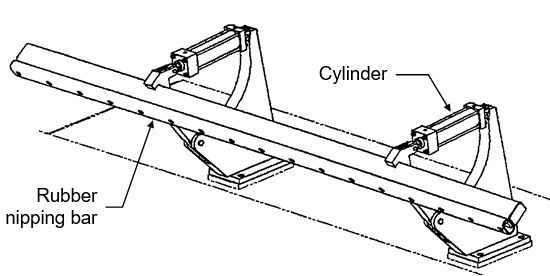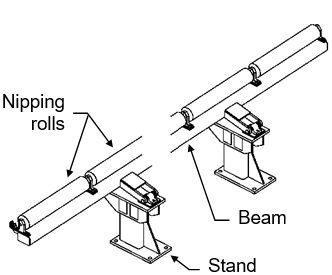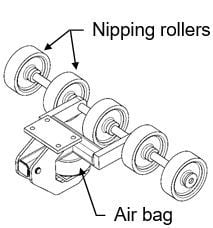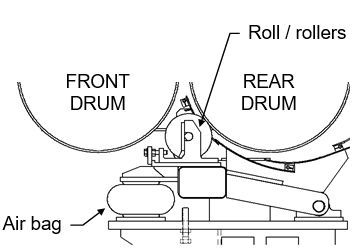Web holder design, principle of operation and maintenance
NOTE: The following information is provided as a reference to understand the general function and design of Valmet web holders. However, design details vary machine to machine. Refer to engineering drawings and component datasheets for project-specific details.
Web holders are used to maintain tension in a threaded sheet during a splicing or set change sequence. They are typically located either adjacent to the guide roll (to facilitate unwind/back splices), or under the rear drum (to facilitate a set change or windup/front splice).
Web holders maintain tension by holding the sheet against an adjacent roll or drum. Designs typically fall into one of two main categories: nipping bars or rolls/rollers. Web holders may be independent assemblies or combined with other equipment. For instance, underdrum web holders are often combined with threading pans or cut-off knife assemblies. Depending on the design of surrounding equipment, web holders may consist of a single full width assembly or separate identical TS/DS assemblies.
Bar design
Design and principle of operation

Typical web holder, bar design
Nipping bar web holders consist of a steel bar with a hard rubber surface and a pivoting frame. During normal operation, the bar is retracted away from the sheet. During splicing or set change sequences, it is loaded against the sheet after the adjacent roll or drum has come to a complete stop. This type of web holder is typically positioned with cylinders.
Maintenance
Design details and maintenance may vary. Refer to engineering drawings and component datasheets for project-specific details.

 |
DANGER: Make sure to lock out the machine before performing maintenance. |

Monthly maintenance
- Inspect cylinders for operation and leaks. Repair kits are available. Refer to supplier datasheets included with your delivery.
Semi-annual maintenance
- Where applicable, lubricate pivot points and cylinder rod eyes (Grease lubrication with EP additives, 7.5% lithium soap base, EP extreme pressure, warmer temp service, NLGI Grade 2).
Annual maintenance
- Inspect bearings/bushings for wear and replace as needed.
Roller design
Design and principle of operation

Typical web holder, nipping rolls design
Roller-type web holders consist of one or more rubber rolls (may be referred to as rollers, depending on the width) which are loaded against the sheet during splicing or set change sequences. The rolls freely rotate, allowing them to be loaded against the sheet while the adjacent roll or drum is still rotating. However, the rolls should only be raised after the roll or drum has slowed to thread speed. The rolls are retracted away from the sheet during normal operation. This type of web holder is typically positioned by inflating/deflating air bags.

Typical web holder, nipping rollers design
During splicing and set changes, the air bags are inflated, raising the rolls to hold the sheet against the rear drum.

Web holder raised against the rear drum
Maintenance
Design details and maintenance may vary. Refer to engineering drawings and component datasheets for project-specific details.

 |
DANGER: Make sure to lock out the machine before performing maintenance. |

Monthly maintenance
- Inspect pneumatic airbag(s) for leaks.
- Check operation of any proximity switches. Replace as needed.
Quarterly maintenance
- Check for wear of rubber rolls.
- Where applicable, lubricate bearings (Grease lubrication with EP additives, 7.5% lithium soap base, EP extreme pressure, warmer temp service, NLGI Grade 2).
Annual maintenance
- Inspect bearings for wear, replace as needed.
For more information on web holders and improving set changes and splicing at your winder, contact your Valmet representative.